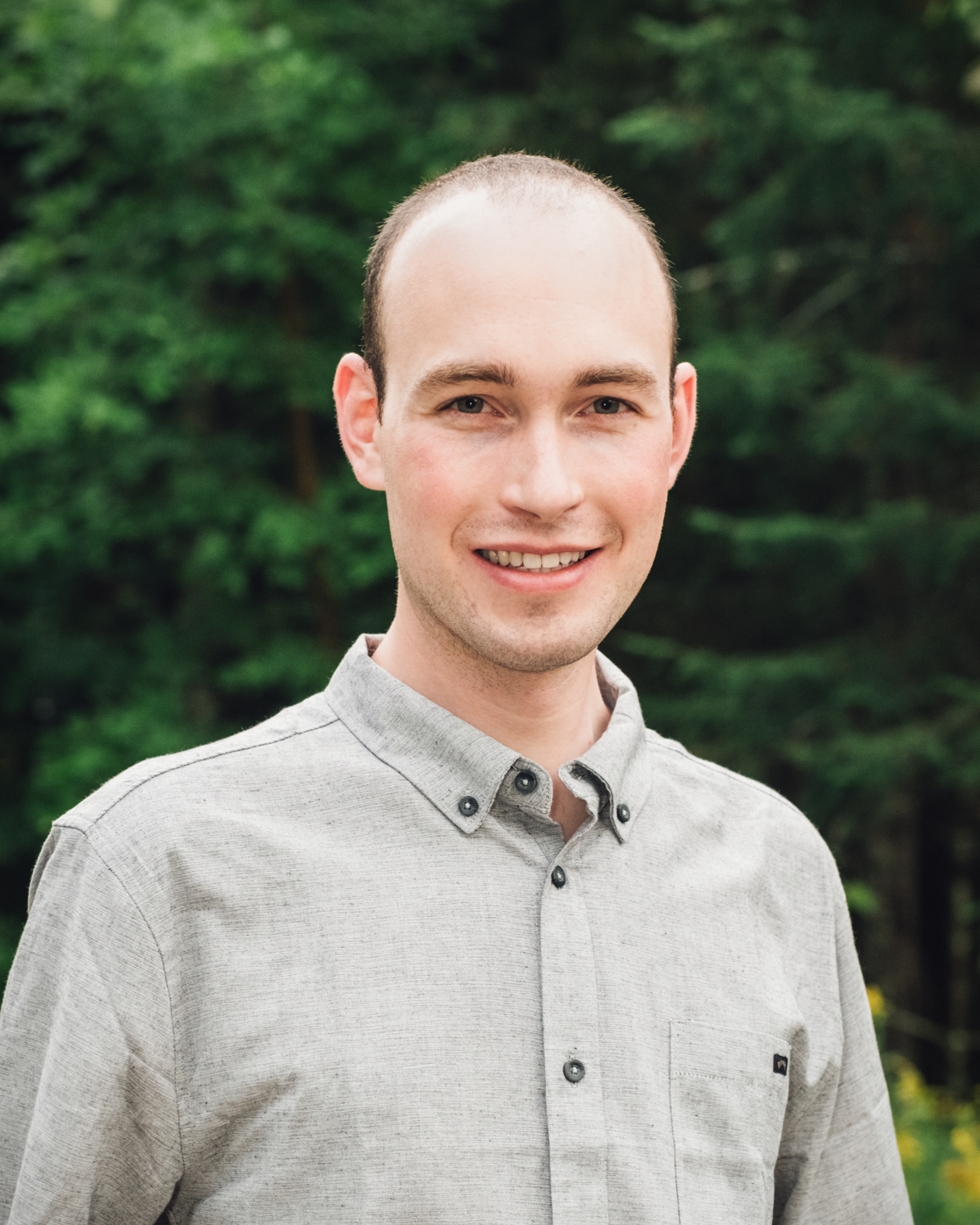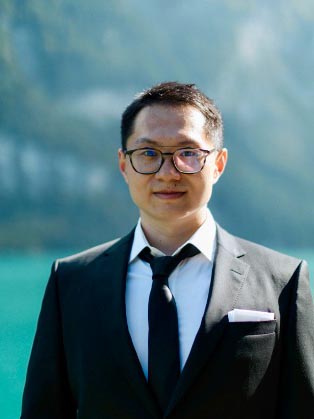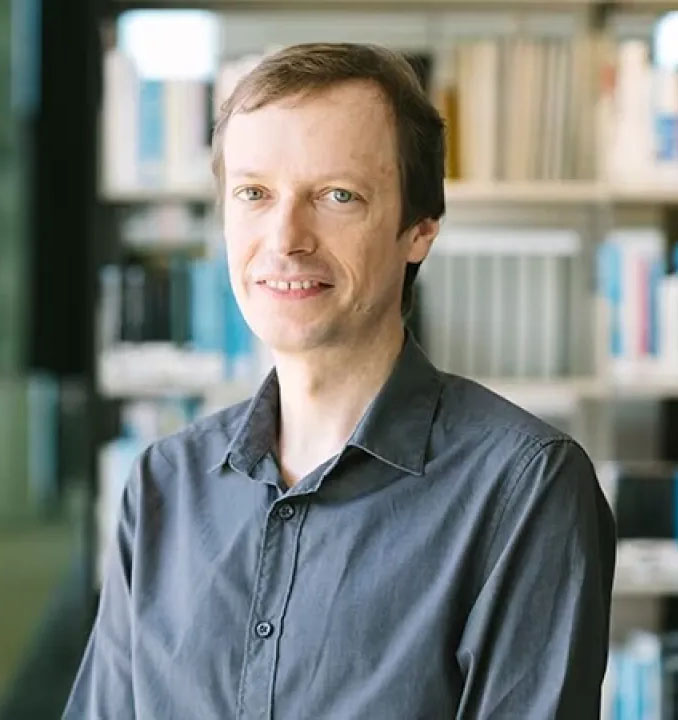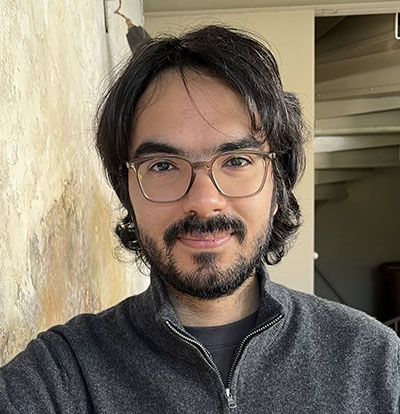
Computing


Abstract: "Discrete Exterior Calculus has become a standard tool for computations on meshes, yet it remains mostly limited to scalar-valued forms. Many geometric and physical systems, however, involve bundle-valued forms together with a connection, for which no widely adopted discrete framework exists.This talk will introduce a discrete analogue of the exterior covariant derivative that extends DEC to forms with values in a vector bundle. We will explore the geometric ideas behind the construction, the role of local frame fields in numerical evaluation, and how the resulting operator preserves key structural properties such as Bianchi identities while converging —in contrast to previous approaches— to its smooth counterpart under refinement."

Abstract: Neural surfaces (e.g. deep implicits and neural radiance fields) have recently gained popularity because of their generic structure (e.g., multi-layer perception) and easy integration with modern learning-based setups. Traditionally, we have a rich toolbox of geometry processing algorithms designed for polygonal meshes to analyze and operate on surface geometry. However, neural representations are typically discretized and converted into a mesh, before applying any geometry processing algorithm. This is unsatisfactory and, as we demonstrate, unnecessary. In this work, we propose a spherical neural surface representation (a spherical parametrization) for genus-0 surfaces and demonstrate how to compute core geometric operators directly on this representation. Namely, we show how to construct the normals and the first and second fundamental forms of the surface, and how to compute the surface gradient, surface divergence and Laplace-Beltrami operator on scalar/vector fields defined on the surface. These operators, in turn, enable us to create geometry processing tools that act directly on the neural representations without any unnecessary discretization or meshing. We demonstrate illustrative applications in (neural) spectral analysis, heat flow and mean curvature flow, and our method shows robustness to isometric shape variations. We both propose theoretical formulations and validate their numerical estimates. By systematically linking neural surface representations with classical geometry processing algorithms, we believe this work can become a key ingredient in enabling neural geometry processing.

Abstract: "The Helmholtz–Hodge decomposition—splitting vector fields or differential forms into exact, coexact, and harmonic components—is a foundational result in differential geometry. It has many applications in computer graphics, especially for geometry processing and physics-based simulation. Its role in fluid simulation is particularly important, as incompressible flow is governed by divergence-free fields. What is less well known is the boundary-aware version of the theorem: the Morrey–Friedrichs decomposition, which refines the classical result into five components. I will present our work showing why these decompositions are crucial for accurately modeling fluids on domains with nontrivial topology and boundaries, and even on non-orientable surfaces, as well as elucidate the associated physical laws. I will also briefly introduce the DeTurck–Gluck seven-component refinement and some of our related ongoing research."

Abstract: Implicit geometry representations such as currents, signed distance functions (SDFs), and more are widely used to represent curved surfaces in computer graphics. While powerful and flexible, these representations often lack key properties of 2D manifolds, such as local parameterization and even integrability. This talk will present approaches for encouraging implicit representations to behave more surface-like, without converting them to meshes and therefore preserving their implicit strengths. We will discuss the geometric notion of what it means to be a 2D manifold, analyze how different implicit representations fall short of this ideal, and discuss optimization schemes that promote surface-like structure. Finally, we will consider the connection between these representations through the lens of geometric measure theory.

Abstract: For the group of area preserving diffeomorphisms we study a class of coadjoint orbits consisting of weighted loops in the plane. They model singular vorticities in ideal 2D fluids supported on closed curves, called vortex loops. We give an Onsager-Feynman condition for the existence of a character associated with a vortex loop. Similar results hold in higher dimensions, for the coadjoint orbits of the group of volume preserving diffeomorphisms consisting of vortex sheets.

Abstract: This talk consists of two recent work, one about topological and geometric analysis on fluid dynamics, and the other about Penroses 8-conic theorem. Vorticity formulation is a widespread description in fluid mechanics. However, its applicability has been limited to simply-connected domains. We show that on non-simply-connected domains, fluids cohomology component plays an important role and can interact with the vortices. This interaction corresponds to a new equation of motion and new conservation laws which can be viewed as Casimir invariants in Hamiltonian formulation of fluid dynamics. The new equation allows us to construct new analytical unsteady solutions to Eulers equation. We also show that viscosity and curvature produce vortices through an elegant formula.
The second part of the talk is about an incidence theorem about conics in double contact, first discovered by Sir Roger Penrose in his undergraduate years but remained unpublished until recently revealed in interviews. The theorem includes as special cases many well-known theorems of projective geometry as well as in metric geometries. Through collaboration with a few projective geometry enthusiasts and Penrose himself, the theorem is further developed.

Abstract: More often than not, we can understand geometry processing methods through the lens of optimization: Techniques for 3D shape editing, simulation, fairing, correspondence, and other tasks can be understood as minimizing a potential function whose variables are associated with a piece of geometry. For this reason, algorithms for large-scale optimization are the unsung workhorses of geometry processing software. Geometry processing problems, however, are structured very differently from problems in domains like machine learning, and hence popular algorithms like gradient descent can fail in unexpected ways in this domain. In this talk, I will summarize lessons learned from designing bespoke large-scale optimization algorithms for geometry processing problems including parameterization, deformation, correspondence, and simulation. Drawing examples from our team's research, I will demonstrate how carefully-designed optimization algorithms can improve the efficiency, stability, and reliability of geometry processing software.

Abstract: Practical problems from computer graphics, computer vision, and computational engineering reveal surprising connections to the physics of crystals, knot theory, minimal surfaces, and algebraic geometry. These mathematical tools help us devise more robust and efficient algorithms. Conversely, computational exploration with these tools can provide mathematical insight and elucidate new theoretical questions. Taking inspiration from applications in neural surface representation and computational meshing, I will lay out a path forward in interdisciplinary applied geometry.

Abstract: Nature provides countless examples of network materials exhibiting exceptional flexibility, strength, and durability—from the acto-myosin networks within our cells, to the trabecular architectures in our bones, to the intricate venation patterns on insect wings. Recent advances in 3D printing technology now enable us to digitally fabricate engineered network materials whose precisely designed structures and compositions begin to rival these biological counterparts in performance. In this talk, I will present several computational models developed during my PhD for simulating and designing nonlinear elastic networks and beyond. At a high level, I will explore how to model 3D-printed elastic networks with tailored channel geometries that mimic real fabrics, how to efficiently simulate geodesic curves on triangle meshes, and how to design structured nonlinear metamaterials with neural constitutive models. On the technical ground, I will discuss techniques for restoring C2 continuity essential for second-order minimization problems, demonstrate the use of variational formulations combined with implicit function theory to efficiently compute complex second-order derivatives, and explain how implicit neural representations can facilitate gradient-based inverse design.

Abstract: Architecture is fundamentally a multidisciplinary discipline, as Vitruvius rightly noted when listing the ten sciences every architect should master. At the top of his list were Geometry and Arithmetic principles that have since evolved into Computer Science, Euclidian and Non-Euclidian Geometry, and Discrete Geometry. Together, they empower us to push the boundaries of spatial and formal expression and minimize energy consumption, material use, and waste.
In this talk, I will showcase my latest research at the intersection of computational design and digital fabrication. Topics include robotic string art, robotic 3D printing of free-form concrete panels, cold bending of glass, curvature-adaptive CNC machining, and novel interactive design tools for designing with developable surfaces. From advanced simulations and optimizations to machine learning as a substitute for traditional finite element simulations, novel results open up new possibilities for solving complex design problems and efficient materialization.

Abstract: In this talk, I will present our group's recent progress in developing particle methods for simulating complex fluid phenomena. I will focus on introducing particle-based data structures and numerical PDE solvers for modeling complex fluid processes characterized by intricate interfacial dynamics, thin-film topology, and vortical structures. I will discuss the roles of particles as interface trackers, differential stencils, and flow-map samplers, enabling the development of effective fluid simulators beyond conventional Eulerian and Lagrangian discretizations. The applications of these methods span a broad range of fluid systems, including surface-tension phenomena, bubbles and foam, particle-laden flows, solid-fluid interactions, and turbulent fluids.

Abstract: Myriad applications, such as geometric modeling and probabilistic resampling, benefit from algorithms to solve nonlinear or nonconvex PDE-based problems. In this talk, I will describe recent efforts with collaborators in which we developed algorithms that tackle nonlinearity and nonconvexity in this setting. In each of these cases, I will demonstrate how the mathematical properties of the problem, such as viscosity or symmetry, can be exploited to design more robust or fast algorithms for a variety of applications in graphics and vision.

Abstract: Signed distance functions (SDFs) are essential for many problems across graphics and vision. But while it is easy to compute the SDF of a closed shape free of defects, it is difficult to robustly compute the SDF of a shape that has been corrupted by holes, noise, or self-intersections. This talk presents the signed heat method for solving this problem: given "bad" geometry, the method gives a good SDF of the unknown uncorrupted geometry, without having to explicitly reconstruct the shape. The method hence simultaneously solves a difficult surface reconstruction problem while computing signed distance. Furthering this theme, this talk presents a unified framework for both reconstruction and distance computation that shows (1) the robustness of the signed heat method is hard to beat, and (2) broader implications for "robustifying" problems beyond distance computation.

Abstract: Consider an electrically conducting fluid (i.e., a plasma) that is initially at rest. If we allow the fluid to relax to a minimum energy state subject to the ideal magnetohydrodynamics (MHD) equations, can we understand the relaxation process or predict the relaxed state? In this talk, inspired by this so-called "magnetic relaxation problem," we explore surprising connections between ideal MHD and conformal geometry, geodesibility of vector fields as well as optimal transport. We also discuss a novel numerical approach to the relaxation of discrete plasma filaments that emerges from these insights.

Abstract: Many tasks in computer graphics, including fluid animation, are typically addressed by discretizing the entire domain and solving large, globally coupled systems. The successes of pointwise Monte Carlo methods in rendering and geometry processing raise the question: can Monte Carlo methods also benefit physics-based simulations?
In this talk, I will present my research aimed at answering this question. Over the past few years, I have developed Monte Carlo fluid simulation methods using vorticity- and velocity-based formulations. A significant part of this research includes advancements in Monte Carlo PDE solvers. These new methods offer flexibility in using substep solvers and can handle complex boundaries without relying on a cut-cell or conforming mesh discretization that traditional approaches require. I will also discuss insights into how our methods relate to existing techniques in computer graphics and conclude by highlighting several open research directions.

Abstract: Curved crease origami transforms flat materials, like paper, into intricate three-dimensional structures by folding along curves. While this discipline is primarily driven by aesthetic exploration, the resulting shapes hold significant practical potential for creating functional, deployable structures that are cost-effective to manufacture. In this talk, I will discuss how the aesthetic qualities of curved crease origami inspire research into developable surfaces and their isometric deformations. Additionally, I will showcase examples of design software that enable the digital fabrication of these complex forms, facilitating their interdisciplinary exploration.

Abstract: This talk will cover two recent projects: In the first half I will discuss solid knitting, a new fabrication method which we recently proposed for making dense, volumetric objects from stacked layers of knit fabric, and will give an overview of the solid knitting machine which we built to automate the process. The layer-by-layer approach of solid knitting is inspired by 3D printing, but because they layers are held together purely by the topological stitch structure---without requiring any sort of adhesive---solid knit objects can easily be unraveled to recover their constituent yarn. In the second half, I will discuss Harnack tracing, a new ray tracing method for visualizing level sets of harmonic functions. Harmonic functions appear ubiquitously in applications from surface reconstruction to architectural geometry, but usually cannot be visualized directly using existing techniques. I will show how our method can be used to visualize smooth surfaces directly from point clouds (via Poisson surface reconstruction) or polygon soup (via generalized winding numbers) without linear solves or mesh extraction, to visualize nonplanar polygons (possibly with holes), surfaces from architectural geometry, and key mathematical objects including knots, links, spherical harmonics, and Riemann surfaces.

Abstract: In the world of interactive computer graphics— spanning video games, virtual reality training, and more— physics simulation plays a fundamental role. However, achieving high-quality, responsive simulations in this context comes with a set of complex technical hurdles. This talk delves into the pursuit of simulations that are not just fast and responsive, but also how the richness of real-time simulations can be ameliorated without sacrificing performance and with minimal changes to existing simulation pipelines. I will explore some of our recent advancements on improving the stability of constrained rigid body simulations, a mainstay of interactive graphics, and additionally showcase new developments on enhancing realism, including advanced friction models, impact and collision responses, and more!

Abstract: Our world is bound by unbreakable physical laws that dictate all our interactions within it: from how we perceive touch, to how we plan and build large-scale infrastructure projects. A fully interactive, physically accurate virtual world would not only allow us to reproduce these interactions cheaply and efficiently, it also allows for the possibility of breaking these laws, widening the scope of what humans can design, build and create. This promises foundational changes in artistic, scientific and engineering disciplines, and has been a long-standing scientific goal since the invention of the first computer displays.
Unfortunately, the road to physical models for virtual interaction is paved with contradictions.
The model needs to be fast enough for interaction, but also accurate enough to model the complexity of various real-world phenomena. The model needs to be realistic enough to inform real-world decisions, while also allowing for non-physical user-interactions which are a central appeal of virtual environments.
Throughout this talk I will outline research I’ve done through my PhD so far, which traverses the treacherous path to interactive virtual physical worlds. In particular I target virtual worlds driven primarily by soft-body physics, which are traditionally neglected in standard fast physics simulation engines. I will show various avenues we can bring reliable soft-body physics to the real-world regime, while also providing design and control interfaces for such soft-body physical worlds.

Abstract: Incompressible fluids enjoy particle relabeling symmetry, giving rise to Kelvin's circulation conservation. For the past two decades, researchers have actively developed methods mimicking this continuous fluid property in discretized simulations. From a computational fluid dynamics (CFD) viewpoint, these discrete models resemble finite difference or finite volume schemes, which unfortunately have limited stability conditions despite the alluring benefits of structure preservations. Thus, non-structure-preserving (but more stable) semi-Lagrangian, fluid-implicit-particle (FLIP), and particle-in-cell (PIC) schemes are still the dominating numerical methods in applied fluid simulations. We propose a new approach to structure-preserving discrete fluids. This approach results in discrete models that resemble the mainstream FLIP or PIC methods but with much more geometric structures. By incorporating isogeometric analysis techniques (i.e. mimetic interpolation), a discrete divergence-free grid velocity interpolates into a smooth divergence-free vector field. Additionally, instead of only moving the positions of the particles by this interpolated velocity field, we act symplectomorphically on both the positions and the momenta by this field. This symplectomorphic group action, therefore, induces a momentum map from the particles' position-momentum space to the dual space of velocities. We argue that this canonical map should be taken as the particle-to-grid information transfer. Since momentum maps preserve the Poisson structure, Hamiltonian flows of particles will map into a coadjoint orbit in the dual Lie algebra of divergence-free velocities. In particular, our method preserves Casimirs, such as 2D enstrophy and 3D helicity. We call our method Coadjoint Orbit FLIP (CO-FLIP), a high-order accurate, structure-preserving fluid simulation method in the hybrid Eulerian-Lagrangian framework. We showcase that traditional simulation methods benefit from structure-preserving techniques by producing higher fidelity vortical structures without the need to have prohibitively high-resolution computation grids.

Abstract: Numerical solutions of partial differential equations (PDEs) are widely used in engineering, especially for modelling phenomena like elastic deformations or fluid simulations. The finite element method (FEM) is the most commonly used technique for discretizing PDEs because of its versatility and range of available (commercial) implementations.
Typically, the PDE solver treats meshing and basis construction as separate problems. However, the basis construction may make assumptions that lead to challenging requirements for meshing software. This can be a significant issue for applications that require fully automatic, robust processing of large collections of meshes or when the PDE solver needs to change the mesh.
We present recent advancements that have led to a unified pipeline that considers meshing and element design as a single challenge. This approach enables a PDE solver that can handle simulations on thousands of domains without requiring parameter tuning.

Abstract: The Laplace Beltrami operator is one of the essential tools in geometric processing. It allows us to solve numerous partial differential equations on discrete surface meshes, which is a fundamental building block in many computer graphics applications. However, discrete Laplacians are typically limited to standard elements like triangles or quadrilaterals, which severely constrains the tessellation of the mesh. This talk presents an easy yet efficient strategy to generalize the Laplace Beltrami and its closely related gradient and divergence operators to more general meshes. Furthermore, we discuss how minimizing the trace affects the spectrum of the polygon Laplacian and how to use this information to improve the operator's robustness and accuracy.